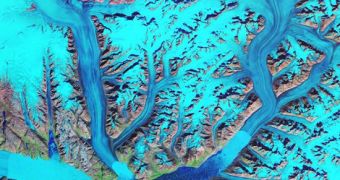A large portion of Greenland's ancient glaciers is currently melting, at a very high speed, say locals. The roaring of the cracks can be heard for tens of miles in all directions. The people near the blocks of ice, who see glaciers melting every summer, reported that the large icebergs that used to come off the ice shelf over the past few years are nowadays being replaced by many small bits of ice, a sign that the glaciers are losing their structural integrity.
A fjord in Greenland is home to the largest glacier in the northern hemisphere, named Sermeq Kujalleq, and it was added to the World Heritage List in 2004 by a United Nations resolution. The impressive amount of ice it contains is constantly flowing towards the ocean, and it would normally stop in winter and resume in the summer. But lately it continues to flow even in mid-winter, which only further goes to show the real impact global warming has on glaciers worldwide. As a result of the temperature increase, Greenland now sees previously impossible things happening on a daily basis.
Agriculture became possible in areas that were frozen stiff a decade ago and the fishing season has increased by a couple of months. And yet, there are a few million people out there who still think that global warming is not a real problem or that it's not as bad to the environment as scientists claim. Regardless of what they might think, the problem is real, as the inhabitants of Ilulissat, a small city in Greenland, prove. The constant cracking noise they can now hear was completely absent a few years back. In addition, they say that they can actually see the ice moving in real-time, although a glacier supposedly moves very slowly. But high temperatures can accelerate their speed considerably.
As an immediate effect of glaciers melting, locals complain about the dwindling supply of fish. Halibut, the main fishing resource, which usually swam at a depth of about 1,000 feet (330 meters), now swims in deeper, cooler water, at about 2,600 feet (900 meters). Since 2007, whales started moving closer to the shores, feeding on the remaining fish and cleaning the waters completely. Some entrepreneurs even began offering tourists whale-sighting trips because whales moved so close.

 14 DAY TRIAL //
14 DAY TRIAL //